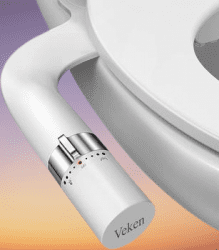where does bidet water come from

Have you ever wondered where the water in a bidet comes from? It’s a common query among bidet users, and one that can sometimes lead to confusion or frustration.
Understanding the source of bidet water is important for troubleshooting any issues that may arise, as well as for ensuring a hygienic and efficient cleansing experience.
In this article, I will delve into the topic of bidet water sources, shedding light on the different possibilities and providing you with the knowledge you need to address any concerns.
Where Does Bidet Water Come From?
Understanding the Source of Bidet Water
Bidets have become increasingly popular in modern bathrooms, offering a hygienic and refreshing alternative to traditional toilet paper. However, have you ever wondered where the water used in bidets comes from?
Maintaining proper hygiene is essential for our overall well-being. Bidets, with their gentle water jets, provide a superior cleaning experience compared to using toilet paper alone. However, the source of bidet water can sometimes be a cause for concern.
Municipal Water Supply
When integrating a bidet into your home comfort system, understanding the source of its water is vital.
For the majority of bidets has a the direct link to the municipal water supply ensures that the water utilized for personal hygiene is as clean and pure as the water you drink or bathe in.
Municipal water, before it reaches the comforts of your home, is subject to stringent regulatory standards. It undergoes a series of rigorous filtration and disinfection processes, such as sedimentation, filtration, and the application of disinfectants like chlorine.
These processes are designed to eliminate particulates, bacteria, and other potentially harmful contaminants, ensuring the water is safe for both consumption and hygiene purposes.
Ensuring Safety and Comfort
Moreover, municipal water suppliers regularly monitor the water quality, adhering to guidelines set by environmental protection agencies.
The water’s pH levels, mineral content, and the absence of harmful microorganisms are meticulously checked. This provides an added layer of assurance that the water you’re using for sensitive personal hygiene, such as through a bidet, adheres to the highest safety standards.
Exploring Alternative Water Sources for Bidets
While the direct connection to a municipal supply covers the needs of most households, certain bidet models and installations offer alternative water sources. This feature caters to specific preferences or requirements, such as the use of filtered or softened water for sensitive skin conditions.
Built-in water reservoirs are one such alternative, where water can be stored and preconditioned before use. This option allows for the incorporation of water softening or additional filtration stages, catering to those with particular skin sensitivities or those wishing to further refine their water quality.
Furthermore, some high-end bidet models provide connections to external water filtration systems. This setup enables users to have complete control over the water’s properties, such as its mineral content or pH level, by leveraging sophisticated filtration technologies.
Whether it’s through reverse osmosis systems, UV light purification, or carbon filters, these adaptations ensure that the water reaches the bidet in its purest form.
Conclusion
he integration of bidets into the home, supported by direct access to the municipal water supply or through alternative sources, marks a significant leap towards enhancing personal hygiene and comfort. The meticulousness of the water treatment ensures that every use of the bidet is not only a luxurious experience but also a safe and healthy one.
As the evolution of bathroom technology continues, the promise of clean, safe, and adaptable water sources remains at the forefront, ensuring that personal care routines are as refined and rejuvenating as possible.
FAQs
1. Where does bidet water come from?
Bidet water typically comes from the same water supply that is used for flushing toilets or faucets in your bathroom. It is connected to the plumbing system and receives water from the main water line in your home or building.
2. Is the bidet water source different in different countries?
The source of bidet water can vary depending on the country and its plumbing infrastructure. In some countries, bidets may be connected to a separate water line, while in others, they may share the same water supply as toilets and faucets.
3. Is bidet water heated or cold?
Bidet water can be either heated or cold, depending on the type of bidet you are using. Some bidet models have built-in water heaters, allowing you to adjust the temperature of the water to your preference. Others may only provide cold water.
4. Can bidet water be recycled or reused?
Bidet water is typically not designed to be recycled or reused. Once the water is used for cleaning purposes, it is directed to the drainage system and goes through the regular wastewater treatment process. It is important to note that bidets use a minimal amount of water compared to traditional toilet paper usage.
5. Are bidets environmentally friendly in terms of water usage?
Yes, bidets are considered more environmentally friendly in terms of water usage. They use significantly less water compared to the production of toilet paper. However, it is important to choose a bidet model with water-saving features and use it responsibly to minimize water wastage.




